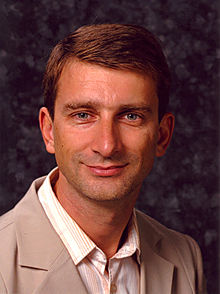Uroš Seljak
Uroš Seljak | |
|---|---|
 Uroš Seljak in 2011 | |
| Born | 13 May 1966 |
| Citizenship | Slovenian, United States |
| Alma mater | University of Ljubljana, Slovenia (1989, 1991) *MIT (1995)
|
| Occupations |
|
| Known for | E and B-modes, CMBFAST code [2] |
| Awards | |
| Scientific career | |
| Fields |
|
| Thesis | Light propagation in a weakly perturbed expanding universe [1] (1995) |
| Doctoral advisor | Edmund Bertschinger |
Uroš Seljak (born 13 May 1966 in Nova Gorica) is a Slovenian cosmologist and a professor of astronomy and physics at University of California, Berkeley.[3] He is particularly well-known for his research in cosmology and approximate Bayesian statistical methods.
Biography
[edit]Seljak completed his secondary education at the Nova Gorica Grammar School and carried out his undergraduate studies at the University of Ljubljana, Slovenia. He graduated in 1989 and later received a Master's degree from the same institution in 1991. Seljak conducted his doctoral research at Massachusetts Institute of Technology and received his PhD in 1995.
After postdoctoral studies at the Center for Astrophysics | Harvard & Smithsonian, he held faculty positions at Princeton University, the International Centre for Theoretical Physics in Trieste, Italy, and the University of Zurich, before joining the UC Berkeley physics and astronomy departments in 2008. He holds a joint appointment with the Lawrence Berkeley National Laboratory.[3]
Career
[edit]Seljak is a cosmologist who is particularly well-known for his research on cosmic microwave background radiation,[4][5] galaxy clustering and weak gravitational lensing,[6] and the implications of these observations for the large scale structure of the universe.[7]
In 1997, Seljak predicted the existence of B-modes in CMB polarization that are a tracer of primordial gravitational waves from inflation.[8] Together with Matias Zaldarriaga, he developed the CMBFAST code for CMB Temperature, E and B-mode polarization, and for gravitational lensing effects on CMB.[4]
In 2000, he developed the halo model for dark matter[9][10] and galaxy clustering statistics.[11]
Much of Seljak's recent work has been focused on how to extract fundamental properties of our universe from cosmological observations using analytical methods and numerical simulations. He has developed cosmological generative models of dark matter, stars and cosmic gas distributions.
Seljak is actively developing methods for accelerated approximate Bayesian methodologies, and applying them to cosmology, astronomy, and other sciences. Examples of this work are the MicroCanonical Hamiltonian and Langevin Monte Carlo and Deterministic Langevin Monte Carlo samplers.
Seljak is developing machine learning methods with applications to cosmology, astronomy, and other sciences. Notable examples include Fourier-based Gaussian processes for analysis of time and/or spatially ordered data, generative models with explicit physics symmetries (translation, rotation), and sliced iterative transport methods for density estimation and sampling.
Honours and awards
[edit]Seljak was awarded the 2021 Gruber Prize in Cosmology jointly with Marc Kamionkowski and Matias Zaldarriaga, who together "introduced numerous techniques for the study of the large-scale structure of the universe as well as the properties of its first instant of existence."[12]
- David and Lucille Packard Research Fellow (2000)
- Sloan Research Fellow (2001)
- Helen B. Warner Prize for Astronomy (2001)[3][13]
- Fellow of the American Physical Society (2013)
- Member of the US National Academy of Sciences (2019)
- Highest cited Slovenian scientist (2019)
- Wiki Science Competition international winner (2019-2020)[14][15]
- Gruber Prize in Cosmology (2021)
- Honorary Doctorate, University of Ljubljana (2023)
- Member of American Academy of Arts and Sciences (2024)
Notable students
[edit]References
[edit]- ^ Seljak, Uros̆ (1995). Light propagation in a weakly perturbed expanding universe (Thesis). MIT. hdl:1721.1/37767. Retrieved September 18, 2023.
- ^ "Overview of CMBFAST". NASA. Retrieved September 15, 2023.
- ^ a b c Faculty profile, UC Berkeley physics department, retrieved 27 March 2011.
- ^ a b Seljak, Uroš; Zaldarriaga, Matias (1996). "A Line-of-Sight Integration Approach to Cosmic Microwave Background Anisotropies". The Astrophysical Journal. 469: 437–444. arXiv:astro-ph/9603033. Bibcode:1996ApJ...469..437S. doi:10.1086/177793. S2CID 3015599.
- ^ Sincell, Mark (30 March 1999). "A New Lens on Dark Matter". Physical Review Focus. Vol. 3..
- ^ "Galaxy Study Validates General Relativity on Cosmic Scale, Existence of Dark Matter", Science Daily, 10 March 2010.
- ^ Becker, Markus (20 April 2005), "Raumzeit-Wellen provozieren Forscher", Spiegel (in German).
- ^ Seljak, Uroš (10 June 1997). "Measuring Polarization in the Cosmic Microwave Background". The Astrophysical Journal. 482 (1): 6–16. arXiv:astro-ph/9608131. Bibcode:1997ApJ...482....6S. doi:10.1086/304123. ISSN 0004-637X. S2CID 16825580.
- ^ Seljak, Uroš; Makarov, Alexey; McDonald, Patrick; Trac, Hy (8 November 2006). "Can Sterile Neutrinos Be the Dark Matter?". Physical Review Letters. 97 (19): 191303. arXiv:astro-ph/0602430. Bibcode:2006PhRvL..97s1303S. doi:10.1103/PhysRevLett.97.191303. ISSN 0031-9007. PMID 17155611. S2CID 22565444.
- ^ Seljak, Uroš; Makarov, Alexey; McDonald, Patrick; Anderson, Scott F.; Bahcall, Neta A.; Brinkmann, J.; Burles, Scott; Cen, Renyue; Doi, Mamoru; Gunn, James E.; Ivezić, Željko (20 May 2005). "Cosmological parameter analysis including SDSS Ly α forest and galaxy bias: Constraints on the primordial spectrum of fluctuations, neutrino mass, and dark energy". Physical Review D. 71 (10): 103515. arXiv:astro-ph/0407372. Bibcode:2005PhRvD..71j3515S. doi:10.1103/PhysRevD.71.103515. ISSN 1550-7998. S2CID 15237151.
- ^ Seljak, Uroš (11 October 2000). "Analytic model for galaxy and dark matter clustering". Monthly Notices of the Royal Astronomical Society. 318 (1): 203–213. arXiv:astro-ph/0001493. Bibcode:2000MNRAS.318..203S. doi:10.1046/j.1365-8711.2000.03715.x. ISSN 0035-8711.
- ^ "2021 Gruber Cosmology Prize". gruber.yale.edu. Retrieved 6 May 2021.
- ^ Warner prize recipients Archived 19 November 2010 at the Wayback Machine, AAS, retrieved 27 March 2011.
- ^ "Commons:Wiki Science Competition 2019/Winners - Wikimedia Commons".
- ^ "Lab Cosmologist Wins Science Photo Competition". Elements Archive. July 31, 2020. Retrieved August 15, 2023.
- 1966 births
- Living people
- Slovenian physicists
- Cosmologists
- University of Ljubljana alumni
- Massachusetts Institute of Technology alumni
- Princeton University faculty
- University of California, Berkeley faculty
- Academic staff of the University of Zurich
- People from Nova Gorica
- Members of the United States National Academy of Sciences
- Sloan Research Fellows
- Fellows of the American Physical Society
